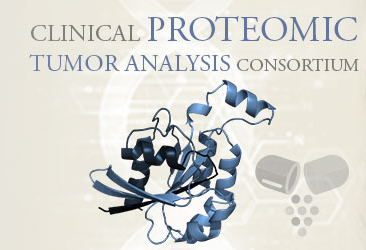Versions Compared
Key
- This line was added.
- This line was removed.
- Formatting was changed.
Summary
| Excerpt |
|---|
This collection contains subjects from the National Cancer Institute’s Clinical Proteomic Tumor Analysis Consortium Acute Myeloid Leukemia (CPTAC-AML) cohort. CPTAC is a national effort to accelerate the understanding of the molecular basis of cancer through the application of large-scale proteome and genome analysis, or proteogenomics. Radiology and pathology images from CPTAC Phase 3 patients are being collected and made publicly available by The Cancer Imaging Archive to enable researchers to investigate cancer phenotypes which may correlate to corresponding proteomic, genomic and clinical data. |
CPTAC Phase 3 collects data from ten cancer types. In TCIA, imaging from each cancer type will be contained in its own TCIA Collection, with the collection name "CPTAC-cancertype". CPTAC Phase 3 Imaging data is made available on TCIA each quarter as it is collected. A summary of CPTAC Phase 3 imaging efforts can be found on the CPTAC Imaging Proteomics page.
Radiology imaging is collected from standard of care imaging performed on patients immediately before the pathological diagnosis, and from follow-up scans where available. For this reason the radiology image data sets are heterogeneous in terms of scanner modalities, manufacturers and acquisition protocols. Pathology imaging is collected as part of the CPTAC qualification workflow.
CPTAC Imaging Special Interest Group
You can join the CPTAC Imaging Special Interest Group to be notified of webinars & data releases, collaborate on common data wrangling tasks and seek out partners to explore research hypotheses! Artifacts from previous webinars such as slide decks and video recordings can be found on the CPTAC SIG Webinars page.
Acknowledgements
We would like to acknowledge the individuals and institutions that have provided data for this collection:
- Boston Medical Center, Boston, MA - Special thanks to Chris D. Andry M.Phil, PhD from the Department of Pathology and Laboratory Medicine, Margaret Lavoye from the Department of Radiology, Elizabeth Duffy, MA and Cheryl Spencer, MA of the Biobank.
- University of Calgary, Alberta, Canada - Special thanks to Marina Salluzzi, PhD and Nicole Blenkin from the Department of Radiology, Calgary Image Processing and Analysis Centre (CIPAC), and Jennifer Koziak from the Department of Surgery.
- International Institute for Molecular Oncology, Poznań, Poland - Special thanks to Maciej Wiznerowicz MD, PhD and Jan Lubiński MD PhD.
- University of Pittsburgh - Special thanks to Rajiv Dhir, MBBS, MBA from the Department of Pathology, and Rose Jarosz from the Department of Radiology.
- St. Joseph's Hospital and Medical Center, Phoenix, AZ - Special thanks to Jennifer Eschbacher, MD from the Department of Neuropathology, Catherine Seiler, PhD, Rosy Singh and Beth Hermes from the Biobank Core Facility, and Victor Sisneros, RT(R)(CT), CPSA.
- Cureline, Inc. team and clinical network, Brisbane, CA - Special thanks to Olga Potapova, Ph.D., Vladislav Golubkov, Ph.D., Victoria Fulidou, M.D., Alexander Sviridov, Dmitry Belyaev, M.D., Oxana Paklina, M.D., Dr.Sc., Galiya Setdikova, M.D., Ph.D., Denis Golbin, M.D., Ph.D.
- Beaumont Health System, Royal Oak, MI - Special thanks to George D. Wilson, PhD from the Department of Radiation Oncology Research, Barbara Pruetz of the Biobank, Debra Kapczynski, MHSA, CIIP, RT(R)(CT) and Rachel Deyer from the Department of Diagnostic Radiology.
- BioPartners, CA - Special thanks to Alexander Gasparian, PhD. from the Department of Drug Discovery and Biomedical Sciences, University of South Carolina College of Pharmacy, Kakhaber Zaalishvili, MD Medical Advisor and Staff Pathologist at BioPartners, LLC, Milla Gorodnia, President of BioPartners, Inc., Victoria Christensen, Global Business Development/Project Coordination Manager, Oksana Havryliuk, MD. Chief of Research department of radiodiagnostics of NCI (Ukraine), Marianna Gredil’, Director of BioPartners, LLC, and Anna Legenka Chief of the Data Department at BioPartners, LLC.
- H. Lee Moffitt Cancer Center and Research Institute, Tampa, FL - Special thanks to John Koomen, Ph.D. from the Department of Molecular Oncology, and Edward R. Seijo, MS and Olya Stringfield, PhD.
| Localtab Group | |||||||||||||||||||||||||||||||||||||||||||||||||||||
|---|---|---|---|---|---|---|---|---|---|---|---|---|---|---|---|---|---|---|---|---|---|---|---|---|---|---|---|---|---|---|---|---|---|---|---|---|---|---|---|---|---|---|---|---|---|---|---|---|---|---|---|---|---|
| |||||||||||||||||||||||||||||||||||||||||||||||||||||

